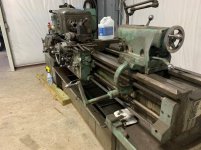stumpjumper400
Plastic
- Joined
- Jul 23, 2020
I recently acquired a 1966 model 612/1610. This machine was listed as having a 7.5 hp motor. I haven't really gone into it other than starting to clean up the outside so far. The original paperwork from Monarch suggested that it was sold with a 15 hp motor so this made me open it up and look. While I can't find the ID tag on it, the motor is definitely not 7.5 but more along the size of a 15. I have gone to some of the phase converter sites and it seems as though a 30 hp phase converter is needed to run at rated capacity. Will I use it at that capacity, probably not. What are your thoughts on converter size? Single phase is the only thing available to me at the shop at this time.
For what I want to do it also needs a steady and taper attachments so I'm on the hunt for those.
For those that run this era of machine, have you found a cheaper supplier than Monarch for the headstock hydraulic filter? I ordered one and wouldn't you know, there are no numbers on it and looks very proprietary.
This is my first lathe of my own so any and all help is appreciated.
Thanks,
Steve
For what I want to do it also needs a steady and taper attachments so I'm on the hunt for those.
For those that run this era of machine, have you found a cheaper supplier than Monarch for the headstock hydraulic filter? I ordered one and wouldn't you know, there are no numbers on it and looks very proprietary.
This is my first lathe of my own so any and all help is appreciated.
Thanks,
Steve




